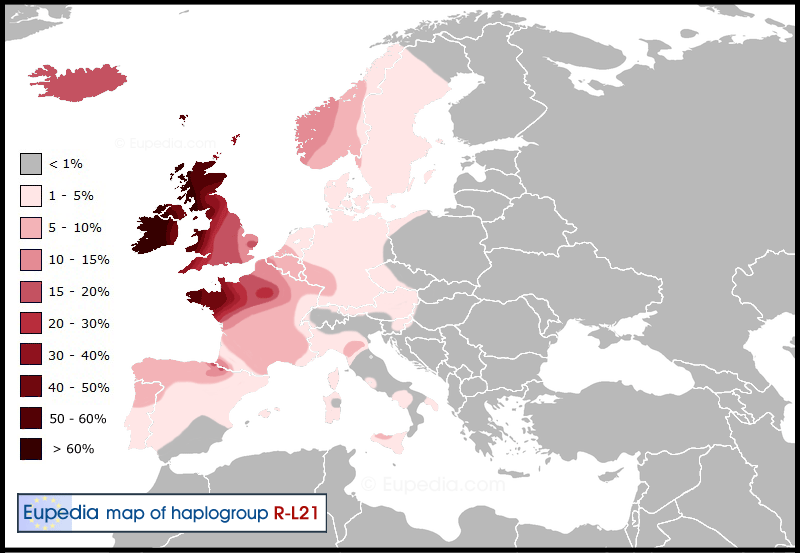Ottimo lavoro, Salar. Tra l'altro, non lontano dal luogo dove sono nato io, a Matelica, nelle Marche, esiste una località di nome
Esanatoglia che prende infatti la sua toponomastica da una divinità celtica, Eso. Insieme a Lug e a Taranis formava la Triade
celtica (anche i Celti avevano la Trinità). Quindi esiste una forte possibilità che anch'io abbia sangue celtico nelle vene.
Credo ti possa interessare,esiste una società Igenea che con un test che ordini su internet,ti permette di stabilire in modo esatto quelli che sono i tuoi antenati,se celtici,germanici o mediterranei.
E' un test scientifico,basato sui polimorfismi del cromosoma y ,che viene ereditato di padre in figlio.
Diversamente per avere un quadro ''statistico'' della situazione,ci sono sul sito Eupedia,oltre a interessanti mappe genetiche dell'Europa,anche una tabella con la tipizzazione genetica regione per regione,ci sono anche le Marche:
http://www.eupedia.com/genetics/italian_dna.shtml#frequencyNello specifico R1b è aplogruppo celtico e germanico,i sottoinsiemi di R1b stabiliscono l'origine precisa,per esempio R1b L21 sono i celti insulari

R1b S28 sono invece i celti ''continentali'',tra cui i galli cisalpini (per esempio i galli senoni delle Marche che potrebbero essere i tuoi antenati)

R1b DF 27 sono i celtiberi

Qui c'è una spiegazione dell'origine e diffusione del ramo italico dei celti
The Italo-Celtic branch (S28/U152)
Starting circa 1300 BCE, a new Bronze Age culture flourished around the Alps thanks to the abundance of metal in the region, and laid the foundation for the classical Celtic culture. It was actually the succession of three closely linked culture: the Urnfield culture, which would evolve into the Hallstatt culture (from 1200 BCE) and eventually into the La Tène culture (from 450 BCE). After the Unetice expansion to Western Europe between 2300 and 1800 BCE, the Urnfield/Hallstatt/La Tène period represents the second major R1b expansion that took place from Central Europe, pushing west to the Atlantic, north to Scandinavia, east to the Danubian valley, and eventually as far away as Greece, Anatolia, Ukraine and Russia, perhaps even until the Tarim basin in north-west China (=> see Tarim mummies.
The Celtic Iron Age (late Halstatt, from 800 BCE) may have been brought through preserved contacts with the the steppes and the North Caucasus, notably the Koban culture (1100-400 BCE).
The Alpine Celts of the Hallstatt culture are associated with the S28 (a.k.a. U152) mutation, although not exclusively. The Italic branch (also S28/U152) is thought to have entered Italy in the 12th century BCE (see Villanova culture below), but there were certainly several succesive waves, as attested by the later arrival of the Cisalpine Celts from Gaul. The Belgae were another S28/U152 branch, an extension of the La Tène culture northward, following the Rhine, Moselle and Meuse rivers.
One common linguistic trait between Italic and Gaulish/Brythonic Celtic languages linked to the Hallstatt expansion is that they shifted the original IE *kw sound into *p. They are known to linguists as the P-Celtic branch (as opposed to Q-Celtic). It is thought that this change occured due to the inability to pronounce the *kw sound by the pre-Indo-European population of Central Europe, Gaul and Italy, who were speakers of Afro-Asiatic dialects that had evolved from Near-Eastern languages inherited from the Neolithic. The Etruscans, although later incomers from the eastern Mediterranean, also fit in this category. It has recently been acknowledged that Celtic languages borrowed part of their grammar from Afro-Asiatic languages. This shift could have happened when the Proto-Italo-Celtic speakers moved from the steppes to the Danube basin and mixed with the population of Near-Eastern farmers belonging to haplogroups E1b1b, G2a, J and T. However, such an early shift would not explain why Q-Celtic and Germanic languages did not undergo the same linguistic mutation. It is therefore more plausible that the shift happened after the Proto-Italo-Celts and Proto-Germanics had first expanded across all western and northern Europe. The S28/U152 connection to P-Celtic (and Italic) suggests that the shift took place around the Alps after 1800 BCE, but before the invasion of Italy by the Italic tribes circa 1200 BCE.
The expansion of the Urnfield/Hallstatt culture to Italy is evident in the form of the Villanovan culture (c. 1100-700 BCE), which shared striking resemblances with the Urnfield/Hallstatt sites of Bavaria and Upper Austria. The Villanova culture marks a clean break with the previous Terramare culture. Although both cultures practised cremation, whereas Terramare people placed cremated remains in communal ossuaries like their Neolithic ancestors from the Near East, Villanovans used distinctive Urnfield-style double-cone shaped funerary urns, and elite graves containing jewellery, bronze armour and horse harness fittings were separated from ordinary graves, showing for the first time the development of a highly hierarchical society, so characteristic of Indo-European cultures. Quintessential Indo-European decorations, such as swastikas, also make their appearance. Originally a Bronze-age culture, the Villanova culture introduced iron working to the Italian peninsula around the same time as it appeared in the Hallstatt culture, further reinforcing the link between the two cultures. In all likelihood, the propagation of the Villanova culture represents the Italic colonisation of the Italian peninsula. The highest proportion of R1b-S28 is found precisely where the Villanovans were the more strongly established, around modern Tuscany and Emilia-Romagna. The Villanova culture was succeeded by the Etruscan civilisation, which displayed both signs of continuity with Villanova and new hybrid elements of West Asian origins, probably brought by Anatolian settlers (who would have belonged to a blend of haplogroups E1b1b, G2a, J1, J2 and R1b-L23).